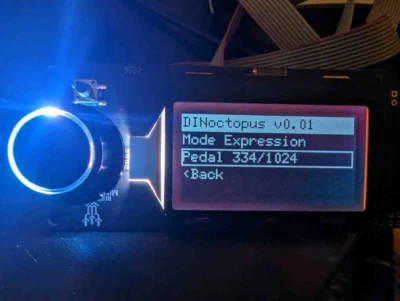[Bjonnh.net]# _
Quick Jupyter Notebook Launcher for KDE
A simple right-click menu option to launch containerized Jupyter notebooks in any directory.
tags kde python
journal Journal of Natural Products
subjects Natural products Pain management NAPRALERT Drug discovery Ethnomedicine Database analysis
I’m organizing a MIDI workshop at PumpingStation One sometime in 2024. I decided to try to Work with the garage door up, and share everything as I am doing it. This is not meant to be a full-fleshed finished documentation more splattering my brain on a wall so I can see more clearly
categories projects music hack techniques rp2040 electronics midi
A small (28x21mm) MIDI board for your microcontroller projects. Especially for RP2040/Pico projects or other 3V3 boards.
categories music hack techniques electronics midi
DINOctopus is a 10 ports small device made that can merge/split/mix MIDI signals and act as a USB interface.
categories projects music hack techniques rp2040 electronics midi
journal Natural Product Research
subjects cytotoxic activity dipyrithione glycosides lyciumphenylpropanoid B Marsypopetalum modestum tuberculosis

The Akai MPC One is a nice device, but it is a pain to backup if you have to get the SDCard out everytime. Using the SSH mod discovered by TheKikGen, it is easy to connect over ssh and get whatever you need.
tags akai mpc

category projects techniques Dash Lotus Wikidata Python RDKit
book title [Medicinal Plants of Laos]
access https://www.routledge.com/Medicinal-Plants-of-Laos/Soejarto-Elkington-Sydara/p/book/9781032077772
subjects Medicinal plants Laos Ethnopharmacology Traditional medicine Biodiversity Conservation
On using 3d printer screens and controllers for your own projects.
I bought some of those cheap 3d printer controllers on the big evil site for $12: BigTreeTech Mini 12864. There are other similar ones in the same price range from other brands, but I can’t guarantee they have the same pinouts and controllers. Also these came with a tiny yellow rubber duck, always useful when you try to make sense of schematics.

The thing is, these are made for 3d printers so they expect you to plug them directly and not worry about implementation details.
Fun thing is, for some printer models, you need to make an adapter cable as nobody seemed to have settled on a standard for those and pinouts are all over the place.
To save you from the hassle of figuring out how to use those with an Arduino or an ESP, and likely for me later when I will need that again, I decided to write down all I discovered about them.
tags arduino electronics midi
I recently got a WD SN850. There is a little trick to do when you receive it to switch it to 4k LBA and thus getting better performance by using native block size.
tags nvme performance
journal bioRxiv
subjects Wikidata Natural products Databases Chemoinformatics
journal Journal of Natural Products
subjects Adipogenesis Artemisia Lipolysis
journal Journal of Natural Products
subjects NMR Adulteration Natural products
I finally put my hands on a Trinket M0 for the Trackpoint. Meaning, no more ugly driver.
tags keyboard ergonomic trackpoint arduino
A friend of mine Pierre Grangé-Praderas needed to make a webpage with graphs. So I decided to play with Cytoscape and Hugo and see if I could integrate them together.
tags graph hugo
I spent a day adding a trackPoint to my keyboard to avoid having to move all the time to the trackball. I wanted something that would allow me to quickly jump from one window to another while keeping my hands on the keyboard.
tags keyboard ergonomic trackpoint arduino
journal Journal of Medicinal Chemistry
subjects Pharmacognosy IMPS Artifacts Cannabis
journal Phytochemistry Letters
subjects NMR Vibrational Circular Dichroism Stilbenoids
journal Journal of Natural Products
subjects Pharmacognosy IMPS Artifacts CPC CCC
Finally, I am trying to reorganize this website, add a portfolio and other kind of stuff that will help me remember the ton of stuff I wrote but never talked about. I’ll document in this article the different kind of things I tried. I am especially excited by the portfolio aspect (of which most will be private though).
tags hugo website

During my PhD, I was working with devices that help separating components of mixtures and devices to analyze these components. However, a lot of manual handling of samples was required between these different devices. So I decided to re-purpose an existing device to solve that. After a little bit of reverse-engineering and the development of a custom control software, problem was solved.
category projects techniques Reverse-engineering Python Qt Serial Nuclear Magnetic Resonance Chromatography

CENAPT Navigator is a compilation of resources related to Natural Product Research and Pharmacognosy. It includes resources on molecular structures, biological activities, spectroscopic data, bibliography, genetics, diseases, pathways, metabolomics…
category projects techniques Javascript SemanticUI HTML CSS Linked Data
journal Journal of Pharmaceutical and Biomedical Analysis
subjects NMR Quality control Peptide Adulteration
journal Frontiers in Plant Science
subjects Pharmacognosy Taxonomy Mass spectrometry Annotation
journal Journal of Organic Chemistry
subjects NMR Quality control Peptide Sequencing
I’m now a heavy user of Draw.io a great piece of Free software from jgraph. However sometimes I need to use it offline… Here is an easy guide on how to use it locally.
tags software diagrams draw.io
I’m moving all my old file-based ssh and gpg keys to a YubiKey 4 hardware key. This post will get updated with a few notes along that migration. It also covers how to use pass and pass-tomb with these. And then I fell down the rabbit hole of using those keys everywhere…
tags gnupg yubikey linux
journal Natural Product Reports
subjects NMR Open Data Natural Products Integrity
[Draft published as is, this is old.] I am playing with Pulsar and Heron in Kotlin. And I was always struggling with getting my kotlin project packaged properly. Here is a walk-through.
tags idea kotlin shadow
I was complaining on IRC about someone sending me a screenshot as a word file. Then my friend Aaron Lav had a comment that I turned into that project.
tags spiders python quick-and-dirty
journal Current Opinion in Biotechnology
subjects Pharmacognosy Computers Data Digital Nanopublications Mining Contextualization
tags ccc cpc conference laser-cutter laser
tags ccc cpc conference laser-cutter laser
journal ACS Medicinal Chemistry Letters
subjects Pharmacognosy Phytochemistry Curcumin IMPs PAINS Letter

journal Journal of Medicinal Chemistry
subjects Pharmacognosy Phytochemistry Curcumin IMPs PAINS Review

journal Journal of Natural Products
subjects Pharmacognosy Phytochemistry NMR qNMR HiFSA

journal Analytical Chemistry
subjects Analytical Chemistry Preparative chemistry Reverse engineering Hyphenation CPC NMR SPE

Posters / NAPRALERT, from an historical information silo to a linked resource able to address the new challenges in Natural Products Chemistry and Pharmacognosy. >

journal Natural Product Reports
subjects Fundamental research NMR raw data


Posters / Reviving NAPRALERT and Making It Ready For Improvement and New Challenges In Natural Products Chemistry and Pharmacognosy >

Posters / Grape Seed Proanthocyanidins: A Novel Source Of Dental Biomaterials And Unique Phytochemistry >


I made some new stuff on this project. Now it has a “working” pre-prototype that can do Wifi+RFID+WS2812 Led ring.
tags ESP8266 Wifi GNU/Linux Tutorial

Using magit-status each time or having to type the commands was boring.
tags emacs magit

Today I received an alert from my work email about a mailbox too full.
tags notmuch cleaning

To test the ESP, the Arduino system is good enough. I’ll explain here the steps to install it.
tags ESP8266 Wifi GNU/Linux Tutorial Arduino

I wanted to make a fretless guitar like Vigier of Ron Thal. With a metal fret board. I’m not there yet…
tags Guitar Fretless Hackerspace PumpingStationOne

How to connect the ESP8266 and how to communicate with the default non-free firmware to test the device.
tags ESP8266 Wifi GNU/Linux Tutorial

I just received my ESP8266-12F from Electrodragon. I’m going to document the steps to use that thing on a GNU/Linux machine.
tags ESP8266 Wifi GNU/Linux Tutorial
journal Analytical Chemistry
subjects Pharmacognosy Phytochemistry MS Fragmentation Molecular Networking Virtual pharmacognosy

journal Journal of Organic Chemistry
subjects Pharmacognosy Phytochemistry NMR FID raw data Spin simulation


Tonight, I played with git hooks. Because I wanted to be able to regenerate the website remotely just by doing a push to a specific branch of the website repo.
tags hugo git hooks lazyness

journal Journal of Medicinal Chemistry
subjects Pharmacognosy Phytochemistry Perspectives Fundamental research IMP bioactivity data mining NAPRALERT

journal Dental Materials
subjects Pharmacognosy Phytochemistry Dentistry OPAC NMR

journal Journal of Organic Chemistry
subjects Pharmacognosy Phytochemistry Dentistry OPAC NMR

Posters / Minimizing the problems with “PIMPs” >

Posters / K-targeted isolation of C-glycosylflavones from Vitex agnus-castus by countercurrent methodology >

Posters / Dissemination of original NMR data enhances the reproducibility of natural product research >

Posters / Chemical nano shifts explain the NMR fingerprints of dentin-enhancing oligomeric proanthocyanidins >

tags rapport son perception
journal Langmuir
subjects Pharmacognosy Phytochemistry Dentistry Polyphenols NMR

journal Dental Materials
subjects Pharmacognosy Phytochemistry Dentistry OPAC NMR

journal Tetrahedron
subjects Pharmacognosy Phytochemistry Vine Wine Stilbenoids Polyphenols CPC Mass Spectrometry

journal Journal of Natural Products
subjects Pharmacognosy Phytochemistry VCD Stereochemistry

journal Journal of Natural Products
subjects Pharmacognosy Phytochemistry NMR Spin simulation


I use Notmuch to manage my emails (and that’s just wonderfully fast) and use the Emacs frontend for it. But when I wanted to save attachements, it was not that easy to create folders. I had to exit the save, open a terminal, a dired or whatever create the folder… I use Helm for managing completion in emacs (and that’s a nice piece of software too).
To avoid that and with the help of Sacha Chua, I managed to add a shortcut in helm read file:
tags emacs helm notmuch
journal Journal of Agricultural and Food Chemistry
subjects Pharmacognosy Phytochemistry Vine Wine Stilbenoids Polyphenols NMR Mass Spectrometry

journal Planta Medica
subjects Pharmacognosy Phytochemistry Vine Wine Stilbenoids Polyphenols Bioactivity

Suite à l’émission de France Inter « Sur les épaules de Darwin, La forme des mots », j’ai décidé d’expérimenter un peu avec la conversion d’images en sons par transformée inverse de fourier.
Pour cela, j’ai utilisé le logiciel ARSS, un peu vieillot, mais qui fait ce qu’il a à faire.
Commençons par un petit exemple, transformons l’image de la formule de cette fameuse transformée en son avec la commande :
tags rapport son perception
journal Journal of Chromatography A
subjects Analytical Chemistry Dereplication LC-NMR Vine Wine

journal Food Chemistry
subjects CPC Oak Wood Flavor Wine

journal Journal of Agricultural and Food Chemistry
subjects Pharmacognosy Phytochemistry Vine Wine Stilbenoids Polyphenols NMR Mass Spectrometry

journal Journal of Agricultural and Food Chemistry
subjects Pharmacognosy Phytochemistry Vine Wine Stilbenoids Polyphenols Bioactivity Antifungal

Conferences / Hyphenating countercurrent chromatography with NMR and mass spectrometry. How to enhance the range of the liquid phases >

journal Journal of Chromatography A
subjects Analytical Chemistry Preparative chemistry Hyphenation CPC MS back-step Vine Wine








































